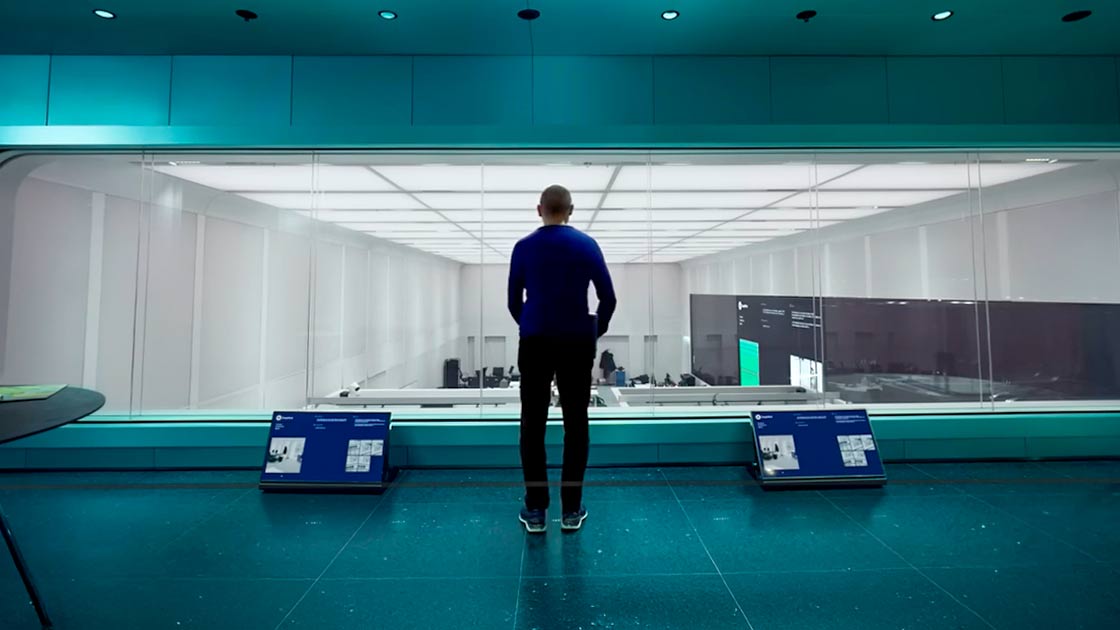Smart Steps: understanding mobility
Smart Steps is a platform developed by Telefónica Tech that is used for crowd mobility analysis. It integrates next-generation technologies, such as Artificial Intelligence and Big Data, to convert anonymized and aggregated data from millions of mobile lines into insights about the behavior of groups of people.
✅These insights help both public administrations and companies to understand in depth the patterns and trends of groups of people and to make informed, data-driven decisions.
In order to protect the individual privacy of users, all data is anonymized at source. In addition, the data is always handled in large volumes to provide useful information, such as relevant mobility patterns on user group behavior, consumption preferences, leisure trends and demographics…
Smart Steps is a powerful tool capable of accurately analyzing crowd mobility and providing valuable information for decision making in numerous industries.
Smart Steps application and uses
Smart Steps is applied in several sectors, such as retail, tourism, advertising and marketing, transportation and logistics, natural resources, and energy, among others.
In general, any company seeking to better understand its potential customers and make data-driven decisions can benefit from this platform in order to, for example:
- Design public transport planning, develop mobility programs and optimize route planning and management.
- Segment users or customers into specific groups according to their characteristics and behaviors. This helps companies to personalize their messages and offers, which can increase the effectiveness of their marketing campaigns.
- Optimize the use of natural resources such as water and electricity or gas distribution and plan the distribution of utilities based on seasonal demand, for example.
- Help companies identify the most strategic locations to open new stores or branches, based on movement and population density data in different areas.
- Better understand their customers' behavior, such as movement patterns, consumption preferences, and leisure activities, among others. This helps them make more informed decisions about marketing, advertising and sales strategies.
- Obtain reports and analysis that allow companies to make faster and more informed decisions. In addition to its potential usefulness in case of crisis, emergencies, or rapid changes in the market.
How Smart Steps works
As we said at the beginning of this post, Smart Steps is an advanced solution that uses new generation digital technologies for companies and administrations to obtain detailed insights about the mobility of groups of people based on mobile line data.
How Smart Steps works can be summarized in the following steps:
- It collects anonymized data from millions of mobile lines. This data includes information on location, movement, and other relevant attributes.
- The collected data is anonymized to protect the privacy of individuals. It is then categorized and aggregated to obtain an overview of mobility behaviors and patterns.
- Use of AI techniques and Big Data analytics to process the data and extract relevant insights. These insights provide information about people's mobility, such as trips made, modes of transport used and socio-demographic profiles.
✅ The insights obtained can also be visualized and delivered in a variety of ways. This includes graphical visualizations, API-like interfaces for data consumption by other applications and customized analysis as needed.
Use case: Mobility insights at MWC
We used Smart Steps during the last edition of MWC to measure the impact of the event on mobility in Barcelona. In this case and thanks to the Smart Steps platform we analyzed anonymously the origin, destination, the time spent and the displacements of the congress attendees as a whole.
As a result of these data, we were able to identify trends in mobility and among visitors, such as the busiest areas, the most common modes of transport, and length of stay, as well as opportunities for improving urban mobility management.
Observed trends include:
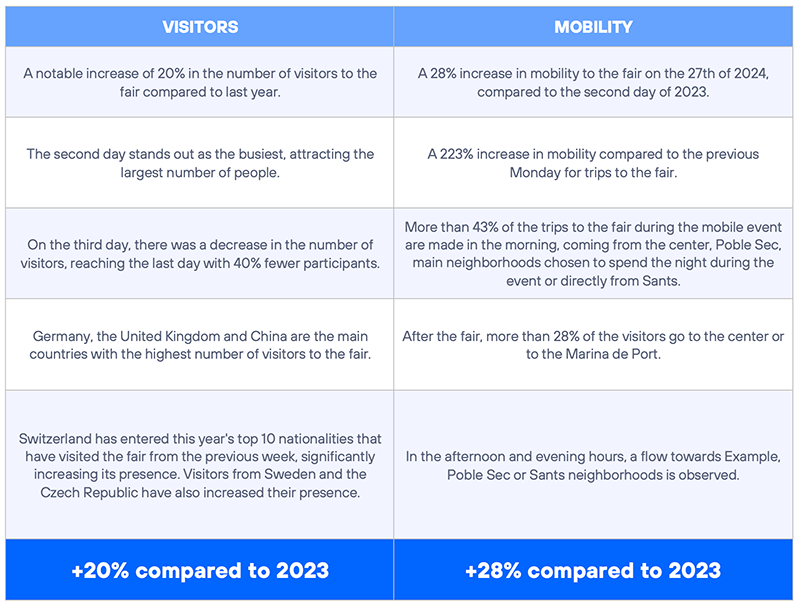 Trends detected during the Mobile World Congress 2024
Trends detected during the Mobile World Congress 2024
The insights gained at MWC are useful for assessing visitor flow, understanding mobility patterns, segmenting visitors, analyzing accommodation preferences, and comparing the event with other similar events.
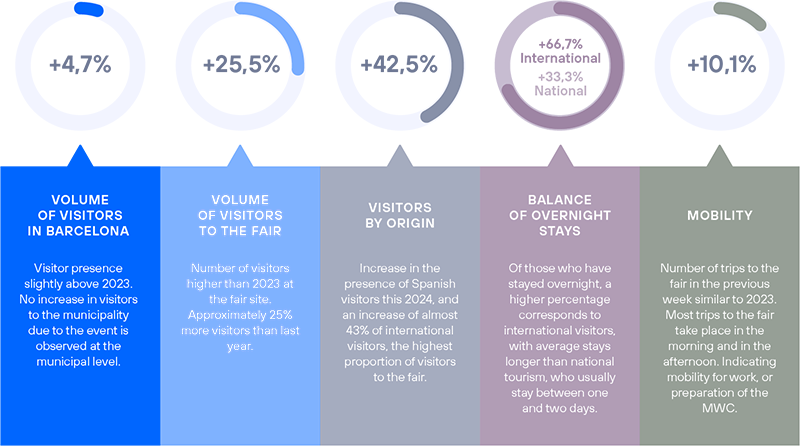 Evolution of visitor flows. Most relevant conclusions recorded from 19 to 25 February (prior to the MWC), contextualized with data from the same week in 2023.
Evolution of visitor flows. Most relevant conclusions recorded from 19 to 25 February (prior to the MWC), contextualized with data from the same week in 2023.
These insights thus provide useful information for optimizing event planning and management, as well as for making strategic decisions related to event planning and its impact on the city's resources and services, including:
- Increased attendance throughout the week at the fairgrounds, with a 25% increase compared to last year.
- 45% increase in the presence of international visitors compared to last year, and more than 65% of overnight visitors were international.
- A pattern of mobility with working hours was observed, with the morning and afternoon stretches being the most frequent at the Fira destination.
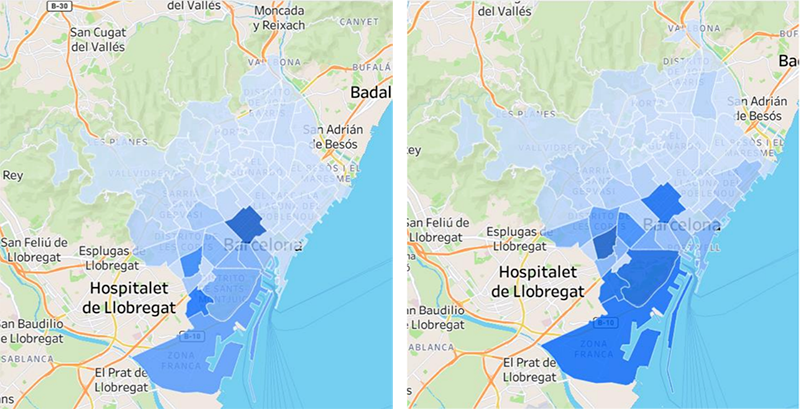 Most visited area in the afternoon (left) is the Dreta de L'Eixample (place of concentration of tourist attractions such as Casa Batlló, La Pedrera, as well as the main commercial areas of the city, Plaza Cataluña, Paseo de Gracia,...) while Poble Sec and La Marina de Port are the most popular neighborhoods for overnight stays before attending the fair (right).
Most visited area in the afternoon (left) is the Dreta de L'Eixample (place of concentration of tourist attractions such as Casa Batlló, La Pedrera, as well as the main commercial areas of the city, Plaza Cataluña, Paseo de Gracia,...) while Poble Sec and La Marina de Port are the most popular neighborhoods for overnight stays before attending the fair (right).
- Dreta de L'Eixample was the most visited area when leaving the Fira, while Poble-sec and La Marina de Port were the most chosen neighborhoods for overnight stays.
- Visitors arriving the weekend before the fair tend to stay mostly in the center, but those arriving directly on the days of the fair opt for accommodation closer to the fairgrounds.
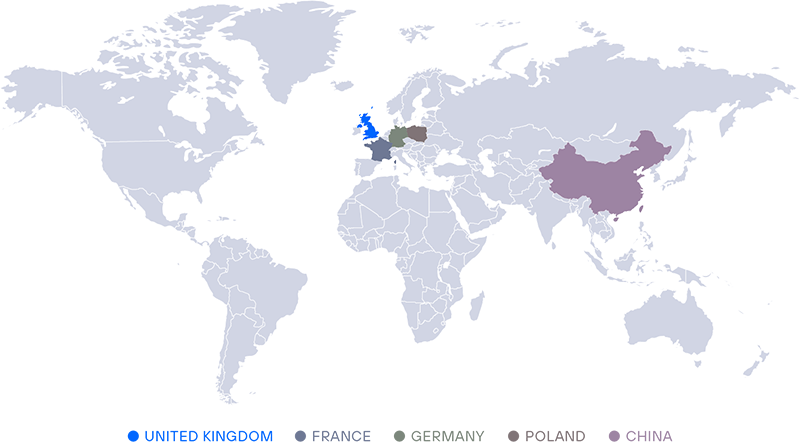 TOP international countries of origin previous week MWC at Fira
TOP international countries of origin previous week MWC at Fira
- Germany, the United Kingdom and China were the main countries with the largest number of visitors at the Fira.
- There was a 223% increase in mobility with respect to the previous Monday in trips to Fira.
- There was a notable increase of 20% in the number of visitors compared to last year, with the second day being the busiest and the last day with 40% fewer participants.
- Travel to the fair during the mobile event took place mainly in the morning, coming from the center, Poble Sec and other nearby neighborhoods.
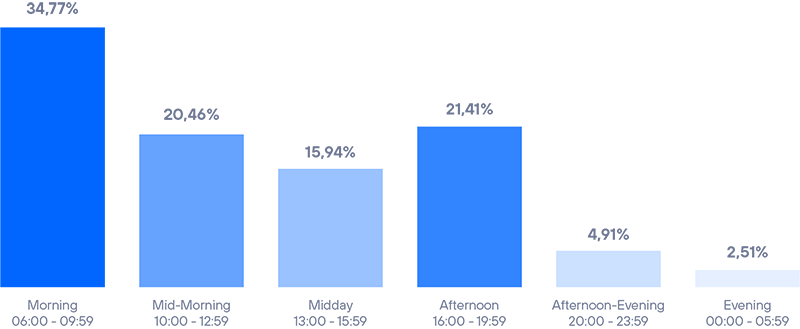 Time slots destinations to the Fair. We can see that the busiest times at the fair are in the morning and afternoon. The most frequent trips to the fair take place in the morning and after lunch.
Time slots destinations to the Fair. We can see that the busiest times at the fair are in the morning and afternoon. The most frequent trips to the fair take place in the morning and after lunch.
Usefulness of the insights provided by Smart Steps
These and other insights with detailed information allow you to analyze different aspects related to the event and visitors. They also help to better understand their behavior and needs during the event, including:
- Identify the flow of visitors throughout the MWC week, comparing data with previous years.
✅ This is useful for evaluating the success of the event and planning future editions or urban services, such as public transportation.
- Information on the origin of visitors, including the percentage of international visitors.
✅ This helps to understand the profile of attendees and adapt marketing, visitor assistance and promotion strategies.
- Knowledge about visitor movements within the city, identifying the most visited neighborhoods and peak times.
✅ This is useful for planning transportation routes, managing logistics and optimizing the attendee experience.
- Identify which neighborhoods are the most chosen by visitors to stay during the event.
✅ This provides relevant information for the city, the hotel industry and allows to adapt the accommodation offer to the needs of attendees.
- Compare the flow and behavior patterns of MWC visitors with other similar events or previous editions.
✅ This provides a broader perspective and helps to assess the relevance and impact of MWC compared to other events in the same sector.
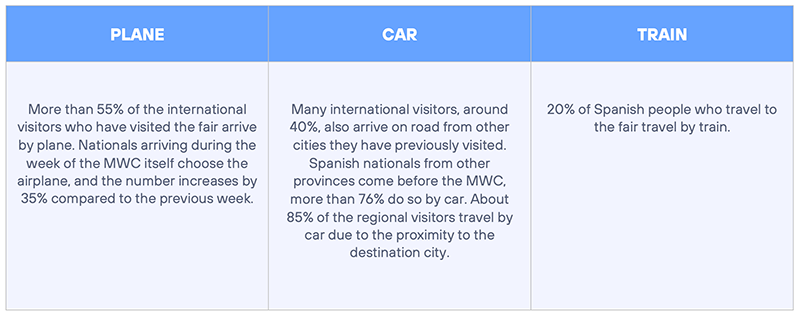 Transportation used by Fira visitors during MWC 2024.
Transportation used by Fira visitors during MWC 2024.
Conclusion
Smart Steps offers significant benefits in many sectors, such as retail, tourism, advertising and marketing, transportation and logistics, and natural resources. It allows optimizing the use of resources, designing public transport planning, segmenting customers, identifying strategic locations, and understanding customer behavior.
Its use during MWC allowed us to better understand the impact of the event on mobility in Barcelona, providing relevant insights for planning and managing the event, on the preferences, trends and needs of attendees and for making strategic decisions related to future editions and other events in the sector.
More,
Photo: Martin Adams / Unsplash.
 Hybrid Cloud
Hybrid Cloud Cyber Security & NaaS
Cyber Security & NaaS AI & Data
AI & Data IoT & Connectivity
IoT & Connectivity Business Applications
Business Applications Intelligent Workplace
Intelligent Workplace Consulting & Professional Services
Consulting & Professional Services Small Medium Enterprise
Small Medium Enterprise Health and Social Care
Health and Social Care Industry
Industry Retail
Retail Tourism and Leisure
Tourism and Leisure Transport & Logistics
Transport & Logistics Energy & Utilities
Energy & Utilities Banking and Finance
Banking and Finance Sports
Sports Smart Cities
Smart Cities.jpg)



